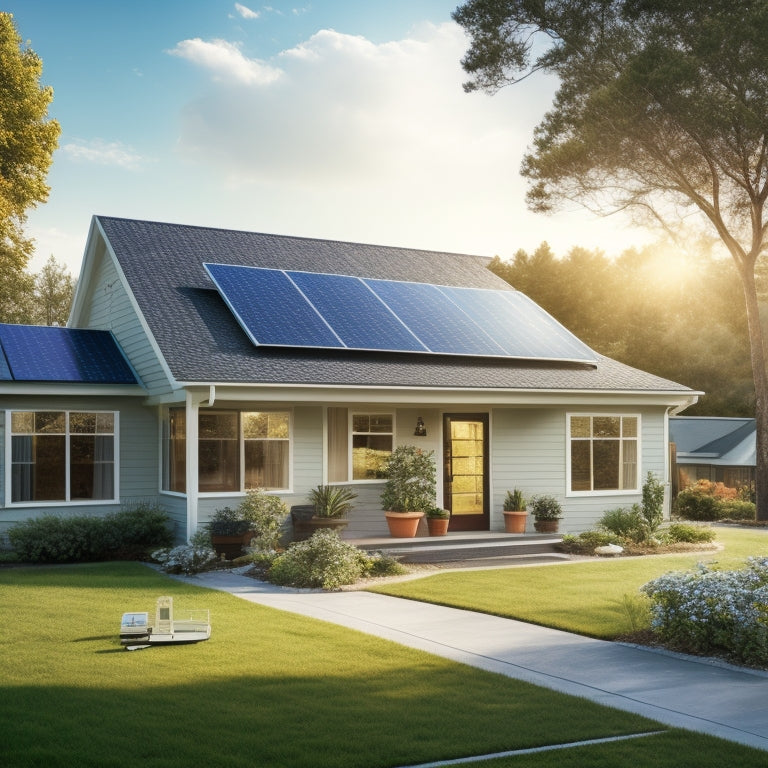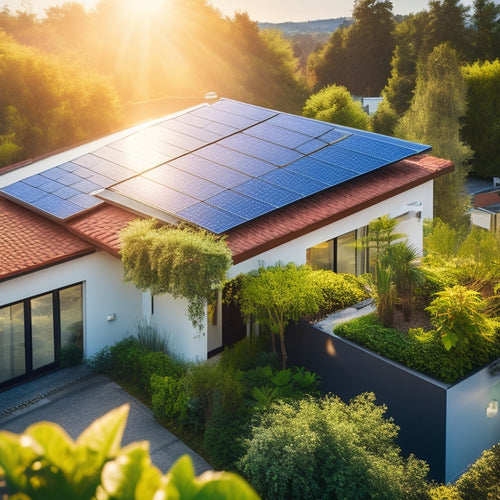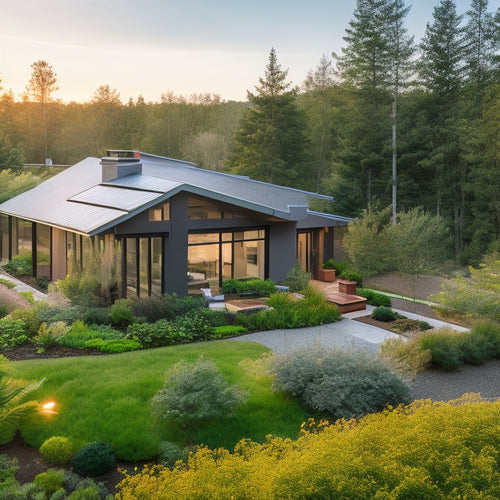
Estimating the Average Cost of a Solar Panel Installation
Share
When estimating the average cost of a solar panel installation, you'll need to take into account various factors that affect the overall price. The type of solar panel, financing options, location, roof size, and quality of installer and equipment all play a role. You'll also need to determine the ideal system size based on your energy usage and roof space. On average, you can expect to pay anywhere from $15,000 to $30,000 or more, depending on your specific situation. To get a better understanding of the costs involved, it is crucial to dig deeper into each of these factors and how they impact your bottom line.
Key Takeaways
- The average cost of a solar panel installation varies widely based on factors like location, system size, and equipment quality.
- Financing options, including outright purchase, loans, and power purchase agreements, can significantly reduce upfront costs.
- System size and cost calculation depend on energy usage, roof space, and local incentives, with cost calculators providing estimated costs.
- Equipment expenses include panel costs (ranging from $0.50 to $1 per watt), inverter costs, and installation warranties, affecting total cost.
- Labor costs, including installation, mounting, and electrical work, constitute a significant portion of total installation expenses, varying by location and installer experience.
Understanding Solar Panel Costs
When you're evaluating solar panel installation, one of the most critical factors to weigh is the cost. You'll want to understand the different solar panel types and their associated prices.
The three main types of solar panels are monocrystalline, polycrystalline, and thin-film. Monocrystalline panels are the most efficient but also the most expensive, while thin-film panels are the least efficient but most budget-friendly.
You'll also need to examine financing options. You can purchase the system outright, which can be a significant upfront investment, or investigate financing options like loans or power purchase agreements (PPAs).
With a loan, you'll own the system and benefit from tax incentives, while with a PPA, a third-party provider owns the system and sells you electricity at a fixed rate.
Additionally, you may be eligible for government incentives, such as tax credits or rebates, which can help offset the cost. Understanding these options will help you make an informed decision about your solar panel installation.
Factors Affecting Installation Prices
Several factors can influence the final cost of your solar panel installation. As you investigate your options, it's crucial to take into account these variables to get an accurate estimate.
When evaluating the cost of your solar panel installation, you should take into account the following factors:
-
Location and climate: The amount of sunlight your area receives affects the number of panels you need, which in turn impacts the cost. Additionally, local building codes, permits, and inspections can vary, influencing the installation cost.
-
Roof size and complexity: The size and shape of your roof, as well as any obstructions like skylights or vents, can increase the installation complexity and cost.
-
Financing options and tax incentives: Your chosen financing method, such as loans or leases, can affect the upfront cost. Furthermore, federal and state tax incentives can reduce the overall cost of your solar panel installation.
- Installer and equipment quality: The reputation, experience, and quality of your chosen installer, as well as the type and quality of equipment, can impact the final cost of your solar panel installation.
System Size and Cost Calculator
To determine the ideal system size for your solar panel installation, you'll need to take into account your energy usage and the available roof space. This calculation will help you determine the required system capacity to meet your energy needs.
A system size and cost calculator can simplify this process by providing an estimate of the total cost based on your specific requirements.
When using a system size and cost calculator, you'll typically need to input your energy usage in kilowatt-hours (kWh) per month, as well as the size and orientation of your roof. The calculator will then provide an estimate of the required system capacity, typically measured in watts (W), and the corresponding cost.
Financing options can also be factored into the calculation, as different financing methods can greatly impact the overall cost of the installation.
Average Cost by Location
Your location plays a considerable role in determining the average cost of solar panel installation. The cost can vary considerably depending on the state, city, and even neighborhood you're in. This is because different regions have different labor costs, permitting fees, and local incentives that can affect the overall cost of the installation.
Some key factors that contribute to the variation in cost by location include:
-
State comparisons: Solar panel installation costs can differ considerably from state to state. For example, California and New York tend to have higher costs due to stricter permitting requirements and higher labor costs, while states like Arizona and Texas have lower costs due to more lenient regulations.
-
Local incentives: Many states and local governments offer incentives, such as tax credits or rebates, to encourage the adoption of solar energy. These incentives can considerably reduce the upfront cost of installation.
-
Labor costs: Labor costs can vary depending on the region, with urban areas typically having higher labor costs than rural areas.
- Permitting fees: Permitting fees, which are required for solar panel installations, can also vary by location, with some cities and counties charging higher fees than others.
Breaking Down Equipment Expenses
As you contemplate the average cost of solar panel installation, it's evident that location plays a crucial role. However, the type and quality of equipment used also have a considerable impact on the overall cost.
The cost of solar panels themselves can vary greatly depending on the type and efficiency of the panels. For instance, high-efficiency solar panels can cost upwards of $1 per watt, while lower-efficiency panels can cost around $0.50 per watt. Additionally, the quality of inverters, mounting hardware, and other components can also affect the overall cost.
When evaluating equipment expenses, it's important to reflect on the installation warranties offered by manufacturers. Reputable manufacturers typically provide warranties ranging from 10 to 25 years or more, which can greatly reduce maintenance costs over the system's lifespan.
You should also think about the durability and reliability of the equipment, as well as any certifications or compliance with industry standards. By carefully evaluating these factors, you can make an informed decision about the best equipment for your solar panel installation and optimize your investment.
Installation Labor Costs Explained
You'll find that installation labor costs account for a significant portion of your total solar panel installation expense.
To better understand these costs, it's crucial to break down the labor cost structure, which typically includes the cost of installing the solar panels, mounting hardware, and electrical infrastructure.
Additionally, you'll need to factor in the costs associated with obtaining necessary permits and undergoing inspections, which can vary depending on your location and local regulations.
Labor Cost Breakdown
Installing solar panels requires a team of skilled professionals, and their labor costs can greatly impact the overall project expense. As you consider your solar panel installation, it's crucial to understand the labor cost breakdown to get an accurate estimate of your project's total cost.
Labor costs vary depending on several factors, including:
-
Wage trends: Labor costs are influenced by local wage trends, which can fluctuate based on demand, supply, and regional economic conditions.
-
Regional differences: Labor costs differ across regions due to variations in cost of living, transportation, and other factors.
-
Installer experience and knowledge: The level of knowledge and experience of the installation team can impact labor costs, with more experienced installers typically commanding higher rates.
- Project complexity: The complexity of the installation, including factors like roof size, pitch, and obstacles, can also influence labor costs.
Understanding these factors will help you better estimate the labor cost of your solar panel installation and make informed decisions about your project.
Permits and Inspections
Obtaining necessary permits and passing inspections are critical steps in the solar panel installation process, and they come with associated labor costs. You'll need to secure permits from local authorities, which can vary depending on your location and the type of installation. These permits guarantee that your solar panel system meets safety and building codes.
| Permit Type | Description | Cost Range |
|---|---|---|
| Electrical Permit | Required for connecting to the grid | $100-$300 |
| Building Permit | Required for roof-mounted systems | $200-$500 |
| Zoning Permit | Required for certain installations (e.g., ground-mounted) | $100-$300 |
Inspection requirements also vary by location, but typically include a pre-installation inspection to verify the system design and a post-installation inspection to confirm the system is installed correctly. Inspection costs are usually included in the overall installation labor cost, but can range from $100 to $500 depending on the complexity of the installation. Keep in mind that these costs are estimates, and your actual permit and inspection costs may vary.
Frequently Asked Questions
Can I Install Solar Panels on My Own to Save Money?
You're considering a DIY installation to reap cost savings, but be aware that it requires significant knowledge and specialized tools, so unless you're experienced in electrical work, it's not recommended, and hiring a professional might be a safer, more efficient choice.
Do Solar Panels Work During Power Outages?
You're wondering if solar panels work during power outages; the answer is, they don't, unless you have a battery backup system or grid independence, which guarantees continuous power supply, optimizing solar panel efficiency when you need it most.
How Long Does a Solar Panel Installation Take?
You're wondering how long a solar panel installation takes. Typically, the installation timeline ranges from a few days to several weeks, depending on the project's complexity and size, with the average project duration being around 3-5 business days for a standard residential installation.
Are Solar Panels Environmentally Friendly?
As you gaze upon a field of sun-kissed panels, you wonder: are solar panels environmentally friendly? You'll find that, from production to decommissioning, the solar panel lifecycle boasts a remarkably low environmental impact, making them a guilt-free gateway to utilizing the sun's power.
Can I Finance My Solar Panel Installation Through a Loan?
You can investigate various solar loan options, which offer financing benefits like low interest rates, flexible repayment terms, and potential tax benefits, to make your solar panel installation more affordable and accessible.
Conclusion
As you step into the world of solar energy, the numbers finally add up. You've got a clear depiction of the costs, from the equipment to the installation labor. Now, the sun shines brighter, illuminating a path to savings and sustainability. With your newfound understanding, you're ready to utilize the power of solar, and the average cost of a solar panel installation is no longer a mystery, but a manageable milestone on your expedition to a brighter, greener future.
Related Posts
-

Solar Power Systems for Cost-Effective Sustainability
Investing in solar power systems is a smart move for cost-effective sustainability. You can save about $1,500 annuall...
-

Integrating Smart Technology for Energy Savings
Integrating smart technology into your home is a transformative factor for energy savings. Smart thermostats give you...
-

Sustainable Home Design for Reduced Carbon Footprint
Sustainable home design is your pathway to a smaller carbon footprint and a healthier living space. By incorporating ...


